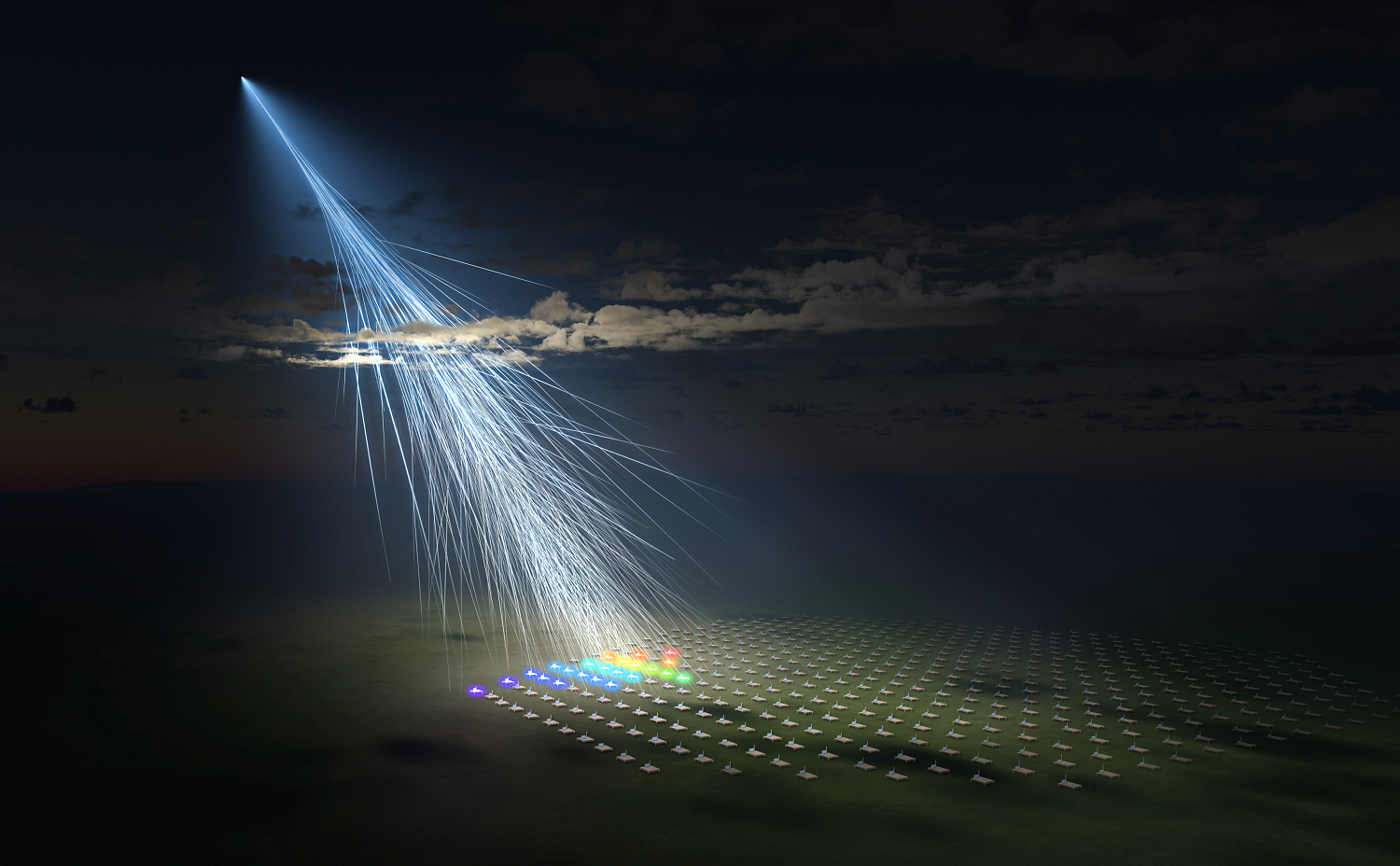A high-energy particle descends from space to Earth's surface, its origin and nature shrouded in mystery. While it might resemble a scene from science fiction, this scenario is an actual scientific occurrence supported by the investigations led by Associate Professor Toshihiro Fujii at the Graduate School of Science and Nambu Yoichiro Institute of Theoretical and Experimental Physics at Osaka Metropolitan University.

Ultra-high-energy cosmic ray captured by the Telescope Array experiment on May 27, 2021, dubbed “Amaterasu”. The detected cosmic ray had an estimated energy of 244 EeV, comparable to the most energetic cosmic ray ever observed. Image Credit: Osaka Metropolitan University/L-INSIGHT, Kyoto University/Ryuunosuke Takeshige
Cosmic rays, energetic charged particles stemming from galactic and extragalactic origins, encompass an array of energy levels.
Among these, exceedingly high-energy cosmic rays are exceptionally scarce, surpassing 1018 electron volts or one exa-electron volt (EeV). This level of energy stands roughly a million times greater than what even the most potent human-made accelerators have achieved.
Professor Fujii and an international team of scientists have dedicated their efforts to pursuing these space-originating rays through the Telescope Array experiment, which has been ongoing since 2008. This specialized cosmic ray detector comprises 507 scintillator surface stations, collectively spanning a vast detection area of 700 square kilometers in Utah, United States.
A significant breakthrough occurred on May 27, 2021, when the researchers identified a particle boasting an astonishing energy level of 244 exa-electron volts (EeV).
When I first discovered this ultra-high-energy cosmic ray, I thought there must have been a mistake, as it showed an energy level unprecedented in the last 3 decades.
Toshihiro Fujii, Professor, Graduate School of Science and Nambu Yoichiro Institute of Theoretical and Experimental Physics, Osaka Metropolitan University
The most energetic cosmic ray of 320 EeV observed in 1991 was dubbed the “Oh-My-God” particle.
Among various potential names for the particle, Professor Fujii and his colleagues reached a consensus on naming it "Amaterasu," drawing from the sun goddess central to Shinto beliefs and credited with playing a pivotal role in Japan's creation mythology.
The Amaterasu particle is as enigmatic as the Japanese goddess herself. The questions were raised about the origin and domain of the Amaterasu particle. The Amaterasu particle might illuminate the origins of cosmic rays.
No promising astronomical object matching the direction from which the cosmic ray arrived has been identified, suggesting possibilities of unknown astronomical phenomena and novel physical origins beyond the Standard Model. In the future, we commit to continue operating the Telescope Array experiment, as we embark, through our ongoing upgraded experiment with fourfold sensitivities, dubbed TAx4, and next-generation observatories, on a more detailed investigation into the source of this extremely energetic particle.
Toshihiro Fujii, Professor, Graduate School of Science and Nambu Yoichiro Institute of Theoretical and Experimental Physics, Osaka Metropolitan University
The research was published in the journal Science on November 24th, 2023.
Funding
The Telescope Array experiment is supported by the Japan Society for the Promotion of Science (JSPS) through Grants-in-Aid for Priority Area 431, for Specially Promoted Research JP21000002, for Scientific Research (S) JP19104006, for Specially Promoted Research JP15H05693, for Scientific Research (S) JP15H05741, for Science Research (A) JP18H03705, for Young Scientists (A) JPH26707011, and for Fostering Joint International Research (B) JP19KK0074.
It is also supported by the joint research program of the Institute for Cosmic Ray Research (ICRR), The University of Tokyo; and by the Pioneering Program of RIKEN for the Evolution of Matter in the Universe (r-EMU).
The study was funded by the US National Science Foundation awards PHY-1607727, PHY-1712517, PHY-1806797, PHY-2012934, and PHY-2112904; by the National Research Foundation of Korea (2017K1A4A3015188, 2020R1A2C1008230, 2020R1A2C2102800); by the Ministry of Science and Higher Education of the Russian Federation under the contract 075-15-2020-778, IISN project No. 4.4501.18, Belgian Science Policy under IUAP VII/37 (ULB), and Simons Foundation (00001470, NG).
The Telescope Array project receives partial support from grants within the joint research program of the Institute for Space-Earth Environmental Research at Nagoya University and the Inter-University Research Program of the Institute for Cosmic Ray Research at the University of Tokyo. Additionally, funding stems from the Dr Ezekiel R. and Edna Wattis Dumke, Willard L. Eccles, and George S. and Dolores Dor´e Eccles foundations.
The State of Utah's backing is facilitated through its Economic Development Board, while the University of Utah contributes through the Office of the Vice President for Research.